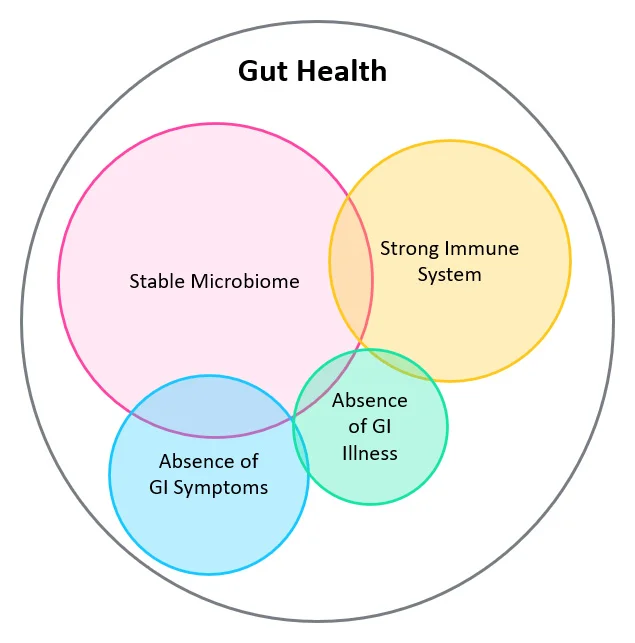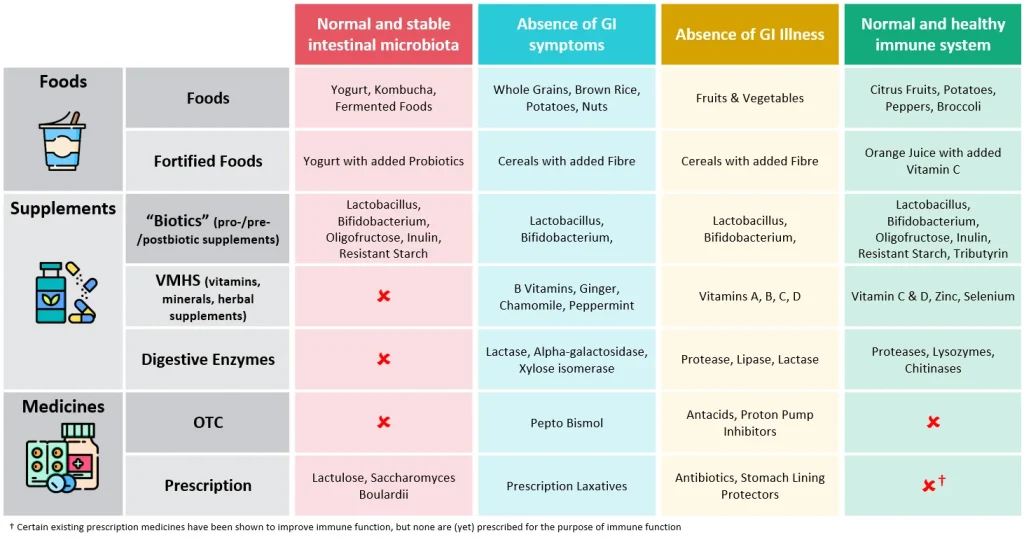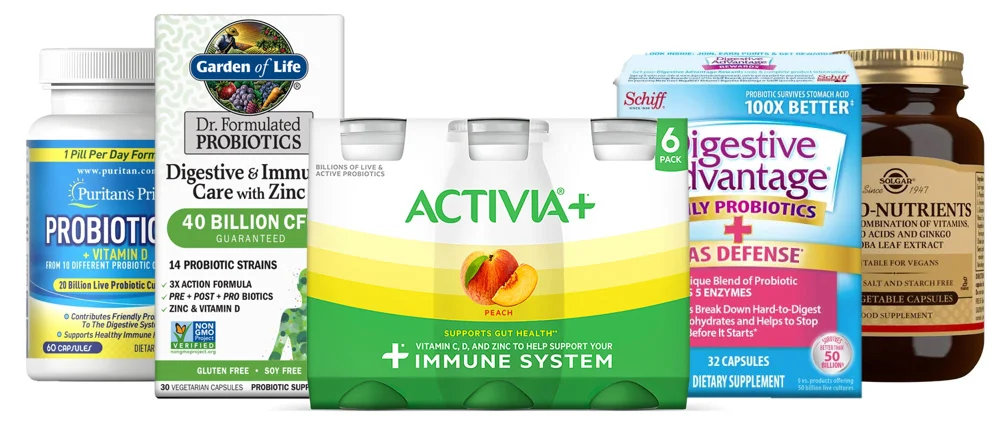
The market for digestive health products has grown to ~$44Bn, driven largely by increased evidence and awareness surrounding the microbiome and probiotics. That said, a healthy digestive system requires more than just a healthy microbiome, and a multitude of other factors outside of the microbiome can influence digestive health. Increased consumer demand for holistic health products means consumer needs also extend beyond the microbiome. Probiotics are therefore in competition with a vast array of other products. The result is a fragmented market with a large number of companies marketing various solutions all claiming to aid gut health.
In such a fragmented market, companies can employ various different strategies to differentiate. These include 1) creating combination products of multiple in-demand ingredients 2) marketing superior quality and evidence, particularly towards healthcare professionals. Creating a successful differentiation strategy will require more in-depth customer research and segmentation than traditional approaches.
Gut health, or digestive health, is a hot topic right now. A 2022 survey by the IFIC (International Food Information Council) of the American population found that one in four Americans considered gut health to be the most important aspect of their overall health1. Commercially, a report by Grand View Research valued the global digestive health market at USD 44.4 billion in 2022 and predicted it to grow at a CAGR of 8.2% until 20302. Academically, a search for the term “gut health” on google scholar now produces over 70,000 results.
This begs the question, what is gut health? Despite increased interest, there exists no consensus definition, commercial or academic3. In popular discourse, the term is often considered synonymous with maintaining healthy and stable levels of gut bacteria, collectively known as your microbiome.
To nurture one’s microbiome, it is recommended to consume products containing “biotics”, either in the form of supplements or functional foods. Traditionally, these recommendations were limited to probiotics and prebiotics, but recent advancements in microbiome research have led to increased buzz around post-, para-, and synbiotics (a full explanation of these terms can be found below)*. There exists a growing body of evidence that consuming biotics is linked with a large range of GI health benefits4.
But the microbiome is only one piece of the puzzle. Although there is a large amount of evidence showcasing the role of the microbiome in gastrointestinal health5, it is not the only factor which determines whether an individual will experience gastrointestinal (GI) issues. For example, many autoimmune disorders can impact GI wellbeing independent of their effects on the microbiome6. An individual may also be genetically predisposed to be at a higher risk for GI diseases7 and symptoms, all without displaying any evidence of having a disrupted microbiome. Conversely, another individual may have an imbalance in their microbiome for years without displaying any symptoms. A comprehensive definition of gut health must therefore extend beyond having a stable microbiome.

Figure 1: displays a suggested mapping of four major categories with which we can think about gut health, whilst also acknowledging the interconnected nature of these categories.
Consumer needs also extend beyond the microbiome. The shift towards a more holistic approach to health means that many consumers see gut health products as a means with which to achieve general health and well-being. The same IFIC survey found that, of the consumers who claimed to use biotics, only 51% cited “supporting their microbiome” as a reason for consumption*. Other reasons cited varied, but can broadly be classified into:
*It is also likely that the 51% who claimed to use biotics for their microbiome do so in the hope of seeing tangible health benefits, such as preventing GI symptoms or illnesses in the future.
These are many of the same reasons consumers cite for the consumption of products more directly associated with gut health, such as digestive enzymes and fibre supplements, but also for products such as whole grains, fruits and vegetables, fermented foods, multivitamins, and other herbal supplements.
Recent research has also showcased the positive GI effects of a multitude of other ingredients. Notable examples include supplementing Vitamins D and B1 when managing inflammatory bowel disease8, the effects of supplementing both digestive enzymes and various herbal supplements (such as ginger) in treating a multitude of gastrointestinal symptoms9,10,11, and the role of minerals such as zinc in improving immune function12.
The result is a market containing a vast array of products, all with some degree of substitutability:

Figure 2: a non-exhaustive mapping of products competing in the gut health market by health claim, product category, and ingredients
Manufacturers looking to capture some of this rapidly growing market are competing along various lines including the health claim of their products, the ingredients, the product category (foods, functional foods, dietary supplements), and the distribution channel (supermarket, pharmacy, online). Despite some increased concentration in the supplement category due to high M&A activity, the market remains highly fragmented (notable transactions included Nestle’s acquisition of various Bountiful Company brands such as Puritan’s Pride and Nature’s Bounty, and Gryphon Investor’s acquisition of Metagenics). A large number of both regional and international manufacturers, many with an extensive portfolio of different solutions, are vying for market share.
This degree of fragmentation is what makes the market ripe with opportunity. With such a wide range of consumer needs, and a diverse set of products which are able to satisfy those needs, ample opportunities exist for manufacturers to differentiate themselves through their marketing, products, and channels. To do so requires a comprehensive understanding of the competition, the commercial landscape, and the profiles of their core customers.
One attractive way for manufacturers to differentiate their products from the competition is through combining different in-demand ingredients into a single product. A notable example is the recent buzz surrounding synbiotic products, a combination of pre- and probiotics. Synbiotics are now projected to grow at a higher CAGR than the probiotics market13,14. Seed Health, a synbiotic start-up known for being endorsed by Gwyneth Paltrow’s brand ‘goop’, recently received $40m in series A funding with which they aim to go beyond the gut.
Many of the largest supplement manufacturers have also started to combine their biotic products with other ingredients including vitamins, minerals, and digestive enzymes. The packaging on these products often mentions other facets of gut health, such as relief of specific symptoms. Concerning functional foods, Activia recently launched their Activia plus range, which added Vitamins C, D, and Zinc to their probiotic yogurt drinks. The marketing materials focus heavily on the interconnectedness between gut health and the immune system.

Figure 3: various large manufacturers have chosen to combine multiple ingredients
Combining ingredients has a lot of distinct advantages beyond being able to make multiple health claims. It can help combat the choice overload consumers face when presented with so many options for their gut health, as well as help remove doubts as to whether they have chosen the correct solution. It can also help combat “pill burden” – the efforts associated with taking numerous pills on a daily basis – including storage, organisation, understanding what each pill does, and keeping track of potentially unwanted interactions. Finally, such a product might be able to command a premium price, whilst still being more cost efficient for consumers.
Nevertheless, combining ingredients comes with its own set of challenges and risks. There is a limit to the quantities of ingredients one can combine into a singular product without impacting the pleasant taste of a yogurt or keeping a pill at a swallowable size. The more ingredients one combines, the lower the dosage of each ingredient and the lower the potential efficacy of the product. Moreover, too many ingredients can also deter consumers; a long ingredient list can make a product seem less natural and therefore less appealing.
Manufacturers therefore need to be very selective in which ingredients they combine. It is crucial to choose these ingredients in a way that aligns with the wants and needs of their consumers. This in turn requires manufacturers to acquire an in-depth understanding of their customer base. To ensure a successful launch of a new combination product, it is essential to conduct scenario analysis grounded in extensive consumer research.
Another angle along which manufacturers can differentiate is by targeting healthcare professionals (HCPs). Although HCPs are unlikely to prescribe gut health products outside of certain medicines to treat GI symptoms, they can be a key influence in driving patients to purchase out of pocket. The IFIC survey found that 43% of consumers would first turn to their healthcare professional to learn more about biotics. Targeting HCPs may allow manufacturers to justify a higher price point if consumers are willing to spend more for a product endorsed by their HCP.
Pure Encapsulations, a vitamin and mineral supplement manufacturer recently acquired by Nestle Health Science, are a tangible example of a company successfully employing this strategy. A 2017 study by the Institute of Functional Medicine found them to be “the most dispensed premium supplement brand by healthcare professionals.” To achieve this, their business strategy has focused on the importance of scientific evidence to build authority and gain the trust of HCPs . The company’s marketing and communications strongly emphasizes the fact that Pure has published over 50 articles in scientific journals. The company also offers both live and on-demand courses and webinars, aimed at HCPs wanting to learn more. For pharmacists interested in stocking Pure products, they promise double the margins of the average supplement.
But convincing HCPs is no easy task. Although four out of five HCPs do prescribe supplements to their patients15, creating brand loyalty requires a manufacturer to demonstrate both quality and efficacy.
HCPs are aware of the less-stringent regulations placed on supplements compared to medicines, resulting in supplements often containing less active ingredient than advertised, or not containing any of the ingredient at all. To assure quality, manufacturers need to make sure they adhere, and ideally exceed, the manufacturing standards set by regulating bodies in each of the countries they operate. Being transparent about their production process also helps to instil faith.
RCTs demonstrating clinical benefits, such as a reduction in GI symptoms, are considered the gold standard amongst HCPs to demonstrate efficacy. These can be very costly to conduct, as well as take a long time to complete. Alongside manufacturers conducting their own research, they should also make HCPs aware of all the existing evidence available on the relevant ingredient(s), so as to let them make an informed decision.
Due to the relative difficulty of targeting HCPs, a well-defined sales strategy is paramount. HCP attitudes and needs in relation to a product are likely to vary both within and between healthcare specialties. The first step in defining a sales strategy should therefore be to segment these HCPs, so as to then identify, quantify, and rank their needs.
Finding the right points of differentiation to compete in a fragmented market can be extremely challenging, but Sector & Segment can help uncover those features which resonate most with consumers and HCPs. The team at Sector & Segment have extensive experience in researching and quantifying the needs, attitudes, and preferences of both consumers and healthcare professionals.
Don’t hesitate to contact us at info@sectorandsegment.com